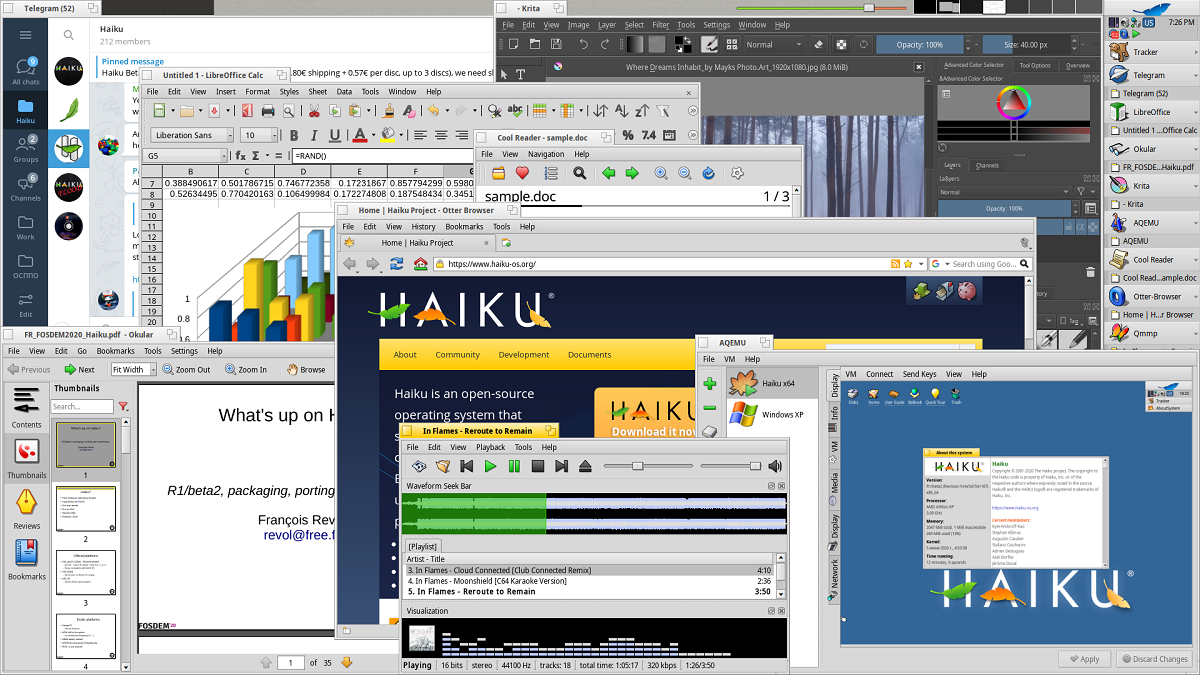
Haiku is an open source operating system under development that is specifically focused on multimedia and personal computing. Inspired by the extinct BeOS
After a year and a half of development, The fourth beta version of the Haiku R1 operating system has been released, which initially, the project was created as a reaction to the shutdown of the BeOS operating system and developed under the name OpenBeOS, but was renamed in 2004 due to claims related to the use of the BeOS trademark in the name.
Haiku OS is designed for personal computers, using its own kernel, built on the basis of a modular architecture, optimized for high responsiveness to user actions and efficient execution of multi-threaded applications.
Main news of Haiku R1 beta 4
In this new version that is presented performance has been improved on screens with high pixel density (HiDPI), along with which correct scaling of the interface has been implemented, not limited to resizing fonts. On first boot, Haiku now automatically tries to detect if you have a HiDPI display and selects the appropriate dimensions to scale.
Another of the changes that stands out in the new version is that the ability to use a skin with a flat window decorator and a flat button style, instead of a design that uses a lot of gradients. The flat design comes with the Haiku Extras pack and is enabled in the appearance settings section.
It is also highlighted that added a layer to ensure compatibility with the Xlib libraryWhich allows running X11 applications in Haiku without running an X server. The layer is implemented by emulating Xlib functions by translating Haiku's high-level graphics API calls.
A layer has been prepared to ensure compatibility with Wayland, allowing tools and applications to run using this protocol, including applications based on the GTK library. The layer provides the libwayland-client.so library, based on the libwayland code and supported at the API and ABI level, which enables Wayland applications to run without modification.
Unlike typical Wayland composite servers, the layer does not run as a separate server process, but rather is loaded as a plug-in to client processes. Instead of sockets, the server uses a native BLooper-based message loop.
Added a working port with Wine which can be used to run Windows applications in Haiku. Of the limitations, the ability to run only 64-bit versions of Haiku and the ability to run only 64-bit Windows applications are mentioned, as well as added a port of the GNU Emacs text editor It works in graphical mode. The packages are hosted in the HaikuDepot repository.
Of the other changes that stand out:
- Support for generating and displaying image thumbnails has been added to the Tracker file manager.
- Thumbnails are stored in extended file attributes.
- Layer implemented for compatibility with FreeBSD drivers.
- Drivers ported from FreeBSD to support Realtek (RTL) and Ralink (RA) wireless USB adapters.
- Of the restrictions, the need to connect the device before boot is noted (after boot, the device is not detected).
- 802.11 wireless stack ported from OpenBSD with 802.11ac support and iwm and iwx drivers with support for Intel "Dual Band" and "AX" wireless adapters.
- A USB-RNDIS driver has been added that allows organizing the operation of an access point via USB (USB tethering) to use it as a virtual network card.
- Added a new NTFS driver based on a library from the NTFS-3G project. The new implementation is more stable, supports file caching layer integration, and provides good performance.
- Added support for 32-bit systems with EFI to the bootloader and the ability to install a 64-bit Haiku environment from a 32-bit EFI bootloader.
- Improved driver for NVMe drives, added support for the TRIM operation to inform the drive about freed blocks.
- The ability to compile the kernel and drivers with new versions of GCC (including GCC 11) is provided, to compile the system due to links to older code, GCC 2.95 is still required for BeOS compatibility.
- General work has been done to improve the stability of the entire system
- Selected options can be changed in settings, but still require a reboot to apply.
- Zoom options are supported by most native apps and some ports, but not all.
If you are interested in learning more about it, you can consult the details at the following link.
Download
Finally, if you want to know more about it and/or obtain the image of this new version, you can do it from the following link. Various bootable live images (x86, x86-64) have been prepared to test the performance of the new version.